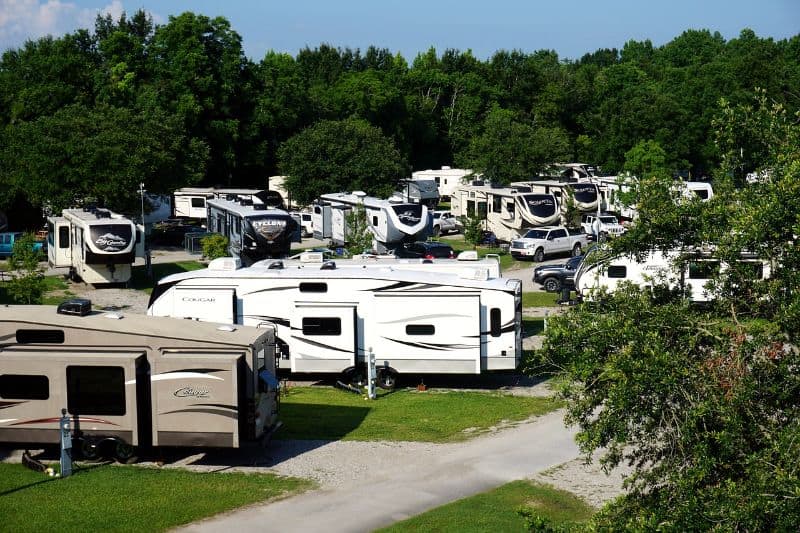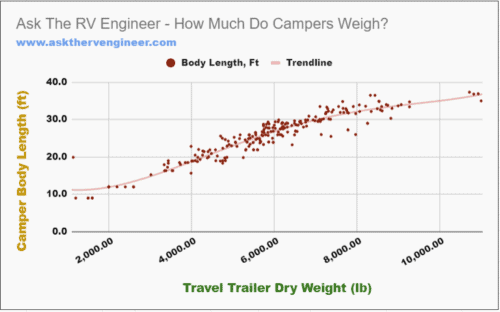So, how much do campers really weigh? Here’s the short answer:
- The average camper trailer weighs around 5,900 pounds and is about 26 feet long. This includes the weight of the travel trailer without any gear or filled tanks.
- Expect to add about 200 pounds of cargo per person and 300 pounds of fresh water.
I calculated this information after surveying more than 200 travel trailers, across 21 product lines, and a dozen manufacturers! This data was gleaned directly from 2020 and 2021 model year specifications from the manufacturers.
Now, obviously, we have much more to discuss:
How long is the average camper trailer? How big of a truck do you need to tow a camper? Does RV construction type affect the weight? Are RV ultra-light packages really 4-season?
Honestly, I’m so excited. I’ve compiled data from 230 campers, and the numbers don’t lie. Let’s dive in.

Camper Weight Stats at a Glance
Survey says: The average travel trailer weighs about 5,900 lbs (dry weight) and is 26 feet long (body length).
This is the dry weight of the camper as delivered to the dealership by the factory. This weight includes:
- The camper structure and built-in furniture
- All OEM features and options, such as awnings and mattresses
- Full propane tanks
It does not include water weight. Also, it may not include battery weight or small dealer-installed options, either.
Roughly speaking, most pick-up trucks with a factory towing package capable of towing 7,500 lbs can tow a camper up to 24 feet in total length.
We’ll talk more about trucks and towing later.

Camper Weight Rules of Thumb
As a general rule, you can expect your trailer without gear and water to weigh about 230 pounds per foot of body length.
That’s per foot body length, not hitch-to-bumper, tip-to-tail length.
Also, you can expect to add about 25 pounds of cargo and water per foot of camper body length.
Alternatively, you can estimate cargo weight at about 200 lbs per person. More on that below.
Cargo Weight Rules of Thumb
- A full “20-lb” propane tank should hold about 15 lbs of liquid propane and weigh in total about 38 pounds.
- A gallon of water weighs about 8.3 pounds. Dirty water, especially black water, can weigh quite a bit more.
- A conventional 3,500-kw gas-powered generator weighs about 100 lbs. Smaller, portable inverter generators weigh about 40-50 lbs.
- The average weight of a mountain bike is about 30 lbs.
Without knowing you or your rig, I can’t estimate precisely how much weight you’ll add to your camper.
If you’re the sort of traveler who lives out of a backpack or briefcase, you may only bring about 40-50 lbs per person. That’s about as much as you’d pack for an airplane flight.
If you’re a gear-freak going for a long week in the boondocks, you could pile on 500 pounds per person!
Psst … if you’re debating what to bring along, check out my article about stuff you don’t really need to pack.
Many RVers don’t travel with full tanks, or they only travel with a full fresh water tank. Just remember: If you fill up a 30-gallon freshwater tank, you’ll add 250 lbs to your camper.
But if you leave a campsite with both your holding tanks bursting at the seams, your freshwater tank half-full, six gallons of water in the water heater … well, you get the idea.
As you can see, you really need to weigh your camper. If you’re new to RVing, or just new to your rig, weigh your camper before every trip. Record the data, and you’ll soon learn how much to estimate for your family situation.
P.S. Don’t forget to include the weight of the dog and cat gear as well!
Real-World Camper Weight Examples
Let’s look at a few of the campers I surveyed.
2021 Jayco Flight M-28 BHBE
- Construction: 2×2 wood frame, fiberglass siding, truss ceiling
- UVW/GVWR: 6640/9250 lbs
- Body Length: 30 ft
2021 Grand Design Transcend Xplor 261BH
- Construction: 2×2 wood frame, corrugated siding, truss ceiling
- UVW/GVWR: 6078/7695 lbs
- Body Length: 26 ft
2021 Northwood Arctic Fox 28F
- Construction: thick-wall aluminum, fiberglass siding, 4-season truss ceiling
- UVW/GVWR: 8302/11000 lb
- Body Length: 28 ft
2021 Coachman Freedom Express Ultra Lite 231RBDS
- Construction: laminate wall, fiberglass siding, truss ceiling
- UVW/GVWR: 5072/7500 lb
- Body Length: 24 ft
2021 Forest River R-Pod RP-195
- Construction: laminate wall, fiberglass siding, cage ceiling
- UVW/GVWR: 3587/4762 lb
- Body Length: 18 ft
Note that the 4-season construction and rough-road chassis of the Arctic Fox adds a significant amount of weight!
That’s an important takeaway. There’s no magic design that both reduces weight AND keeps costs down. If you purchase a 4-season camper, be prepared for a weight penalty.
Understanding RV and Camper Weight Numbers
There are multitudes of weight and capacity numbers for RVs! One salesman keeps talking about GVWR; the other mentions dry weight; another shares curb weight information.
It’s confusing, I know. For a full discussion of RV weight terms, check out my RV Glossary.
Here’s an abridged explanation:
Unloaded Vehicle Weight (UVW)
The actual weight of the camper as delivered to the dealership by the factory. It is the weight of the camper itself, with no water or cargo.
Unfortunately, people use a lot of deprecated synonyms for UVW: dry weight, factory weight, empty weight, etc. Really, these should all refer to the UVW.
If you parked an empty camper on a scale, you would measure the UVW.
Gross Vehicle Weight Rating (GVWR)
The maximum allowable weight of the camper with waters filled, gear loaded, etc. The camper is not allowed to ever weigh more than its GVWR!
The difference between GVWR and GVW is that the former is a rating and the latter is a weight measurement.
If you parked a fully loaded camper on a scale, you would measure the GVW, and you should double-check it is less than the GVWR maximum.
Tongue Weight (TW)
Also known as the dry hitch weight, the tongue weight is the actual weight at the trailer tongue ball coupler or tow vehicle ball hitch point.
Usually, the tongue weight should be 10-15% of the UVW.
The manufacturer has the responsibility to design the empty unit so that 10-15% is on the tongue, and the customer has the responsibility to load the cargo so that the 10-15% ratio is maintained.
To measure the actual tongue weight, you can get reeeeeally close by placing the A-frame tongue jack on a scale. The weight at the ball hitch itself will be a few pounds more.
Cargo Carrying Capacity (CCC)
This is the maximum allowable weight of all added cargo, including water tanks, water heater capacity, full tank of propane, and a few other minor items.
CCC is a somewhat new term adopted by the RVIA in 2020. It supersedes an old term, Net Cargo Capacity (NCC), which optimistically overshot the real-world cargo capacity.
Does Construction Type Affect Camper Weight?
I have two answers to this question.
Answer 1: Yes it does!
Answer 2: No, it doesn’t.
Now, these answers may sound like oxymorons, but there’s the catch.
4 Main Types of RV Construction
There are four basic RV superstructure types:
- Stick n’ tin, where corrugated siding or backed fiberglass is applied to a 2×2 stick-built wooden frame.
- Some manufacturers use an advanced method of stick n’ tin models, relying on residential 2×4 framing and sheathing methods.
- Structural aluminum cage, where a welded aluminum frame supports the weight of the shell and all components.
- Laminate (aka sandwich, composite), where composite panels with a foam core and interior tubing are bonded to a seamless exterior skin. You often see laminate sidewalls and floors.
- Monocoque, where the skin of the camper shell is also loadbearing. For instance, all molded fiberglass campers – and a few others, like Airstream – have monocoque shells.
You can learn everything else there is to know about my guide to RV sidewall types.
There are many distinctions between these four, but those are the basics.
Stick n’ tin construction hasn’t changed much since the 1980s. These campers often have 2×2 wood-framed walls, solid OSB floors, solid wood roof trusses, etc.
The more modern approach takes advantage of the weight savings and superior strength of composite panels. These RV trailers may have vacuum-bonded laminated fiberglass walls, composite floors, and molded fiberglass caps.
Other advanced weight-saving techniques include:
- Chassis frames made from HSLA steel sheet metal
- Foam-cored cabinet doors and poplar-core plywood furniture
- Replacing traditional plywood with Azdel or structural foam plastic products
Why Laminate Construction Doesn’t (Always) Weigh Less
Vacuum-bonded walls and floors do save a lot of weight! But they’re also usually found on medium- and higher-end campers. These are luxury campers. And they often come with extra features, like more storage cabinets, washers and dryers, solid surface countertops, etc.
And guess what? These luxury features add more weight of their own!
So, the real answer is a little more complicated. If you’re shopping for a lightweight trailer, yes, you should look for advanced construction methods. But you have to keep a careful eye on standard features.
Extra-Heavy RV Construction Features

If you’re shopping for an ultra-lightweight camper, you need to consider more than just construction type.
- Does the camper have motorized slide-outs? A slide-out can add 500-800 pounds of weight!
- Does the camper have dual axles? A dual axle can add another 200-300 pounds of weight – but honestly, I’d still recommend a dual- over a single-axle. They are much safer to tow and easier to back up.
Do Ultra Lightweight Campers Actually Weigh Less?
Now, this is where things get interesting!
My data showed a percentage weight difference of just 3.24% between regular and lightweight travel trailer models.
That’s so small, it’s negligible. That could easily just be errors in my sampling.
However! – don’t go yet! —
Then I compared average weights within manufacturers. I wanted to know how much “lighter” were their lightweight models compared to their regular models?
And the results are all over the place!
Between the Jayco Flight and Feather lines, the Feather is a whopping 15% lighter! That’s fantastic!
But when I compared the Starcraft Autumn Ridge to their Super Lite lineup, the Superlight is almost 11% heavier!
What’s going on here?!
Rules for Comparing Lightweight Campers
1) Compare Similar Construction Types
First of all, you need to compare apples to apples. Stick within the same product type. Don’t expect to compare lightweight stick n’ tin aluminum-sided camper with a vacuum-bonded
2) Compare Similar Price Points
As I mentioned earlier, luxury features can easily throw off weight comparisons. Only compare models within 10-15% of each other’s price points.
3) Compare Similar Sizes
It may sound silly, but if you’re comparing weights, don’t compare an agile 24-ft camper to a 38-feet bunkhouse behemoth!
In fact, for the best accuracy, check the widths and heights as well. Travel trailers can be as narrow as 7 feet and as wide as 8 feet, 6 inches. Height can also vary.
Camper Weight Chart Results
Now for the good stuff! Here’s the chart of my results after analysis.

1) As Camper Length Increases, Weight Penalty Decreases
If you’ve ever stepped in a camper, this makes intuitive sense. Small campers pack a lot of stuff in a small space! Destination glampers, meanwhile, offer lots of open space.
2) Common travel trailers weigh 4,000 – 8,000 lbs
As you can see, the dot clusters become sparse after 8,000 lbs and before 4,000 lbs.
You don’t find much heavier than 8,000 lbs for a pretty simple reason: Hardly anyone can tow them! The only trucks big enough to tow a 10,000-lb travel trailer are also big enough to tow a goose-neck or fifth-wheel camper, which are vastly preferable at that weight.
Also, most travel trailers have dual axles. Turns out, suspension axle configurations capable of carrying more than 5,000 lbs are exponentially more expensive.
If you’re shopping for a camper that weighs under 4,000 lbs, don’t despair! Actually, Most major manufacturers offer short, lightweight campers. They just aren’t offered in as many floorplans.
Plus, here are some ultra-light miniature travel trailer manufacturers.
- Molded Fiberglass: Casita, Scamp, InTech
- Oversized Teardrops: NuCamp, Little Guy, Forest River R-Pod
- Adventure Travel Trailers: Flagstaff, Winnebago,
Outside of the travel trailer world, there are pop-ups, teardrop trailers, and other fun-sized towable campers.
3) Rule of Thumb: Camper Size +/- Four Feet
For a set weight of travel trailer, you can go up or down about 2-4 feet from average.
That might sound a little confusing. Here’s an example.
The average 6,000-pound camper trailer is about 28 feet long. You can see this on the graph.
Now, see those outlier dots? That tells you that a “lightweight” 6,000-lb trailer might be as long as 32 feet, and a “heavy-duty” 6,000-lb trailer might be as short as 24 feet. But you’re not likely to find a 38-ft or 22-ft camper that weighs 6,000 lbs.
Do I Need a Bigger Truck to Tow My Camper?

So, after all this math, what are we left with?
After all, I’m guessing you’re interested in camper weight so you can choose the right size of truck. I dive deep into this question in this article.
For now, a simple back-of-the-envelope equation is that a typical half-ton pickup truck capable of towing 7,500 lbs can tow a camper 24 feet or less.
If your camper is longer than 24 feet, you’ll probably need a three-quarter or one-ton truck.
Now, this is a rough-around-the-edges rule! It’s sufficient for walking around a dealership lot, not for actually purchasing a camper!
To get started, look at the VIN sticker on the inside of the door jamb. It will tell you the vehicle’s maximum tow rating as specified by the manufacturer.
You don’t want to max out your truck tow rating!
- You’ll risk burning out the transmission, especially on long, steep grades.
- You might wear out the rear suspension, especially if it’s a coil spring setup.
- You won’t be able to tow your camper at traffic speeds on steep grades and at high elevations. Then everybody will hate you and call you mean names as they pass you.
There’s an old rule for towing called the “80 Rule.” In other words, your actual camper weight should be 80% or less of your maximum towing capacity.
Again, for most of you, this rating is too generous. Rough terrain, high elevation, and even the condition of your truck will reduce your effective towing capacity.




Leave a Reply